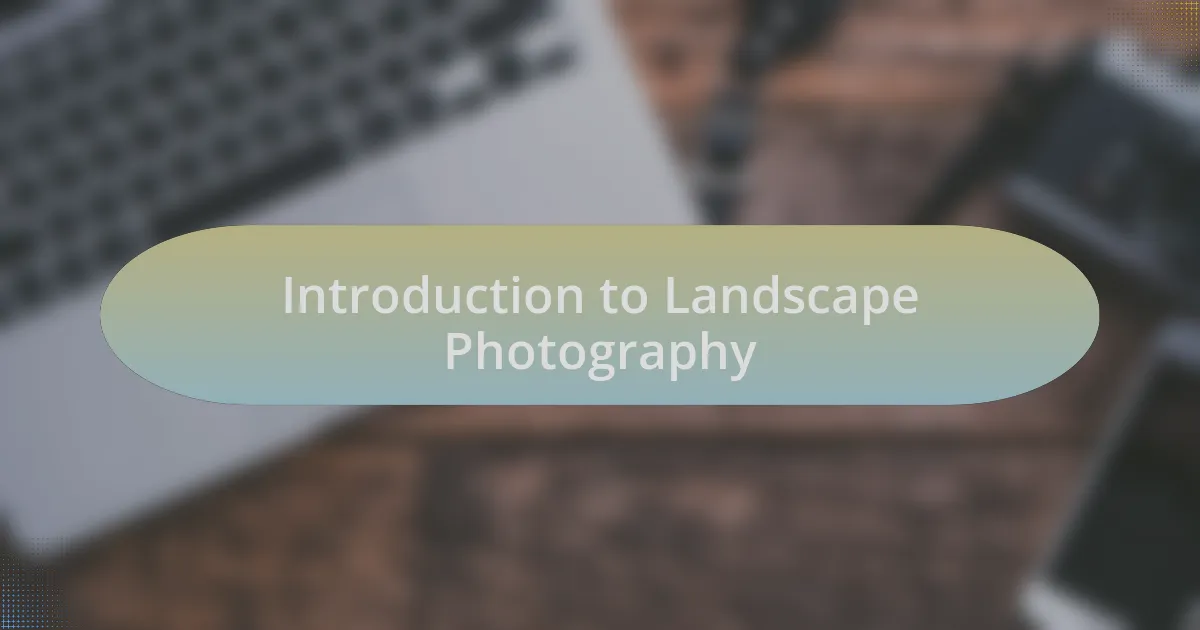Key takeaways:
- Landscape photography is about evoking emotions and connecting with your surroundings to enhance the narrative of each shot.
- The right equipment, particularly tripods and filters, is essential for capturing high-quality landscape images.
- Understanding and utilizing lighting conditions, such as the golden hour and cloud cover, can significantly impact the mood and quality of photographs.
- Compositional techniques like the rule of thirds and incorporating foreground elements help create depth and draw viewers into the scene.

Introduction to Landscape Photography
Landscape photography is more than just capturing a scene; it’s about evoking emotions. I still remember standing atop a cliff at sunrise, feeling the cool breeze and the warmth of the first light. That moment changed my understanding of photography—it taught me that the essence of a landscape can resonate deeply within us.
When I look through the viewfinder, I often ask myself: What story does this landscape want to tell? In my experience, the best landscape shots often reveal something unexpected, a hidden detail or the interplay of light and shadow that breathes life into the image. It’s these subtle nuances that transform a photograph from a simple depiction to a captivating narrative.
As you dive into this genre, it’s essential to connect with your surroundings. I often take a moment to breathe in the scenery—whether it’s the vastness of a mountain range or the delicate curves of a sand dune. This connection not only enhances my experience but also translates into the photographs I take, allowing me to share the beauty that moved me in the first place.

Importance of Equipment Choices
When I first started photographing landscapes, I quickly learned that the right equipment can make or break a shot. I remember a chilly morning when I reached a stunning viewpoint only to realize I’d left my tripod behind. The steady support of a tripod isn’t just a convenience; it’s essential for capturing long exposures that reveal the movement of clouds or water, resulting in those dreamy, silky textures that transform a good photo into a great one.
Choosing the right lens can also have a significant impact on your composition. For instance, I often use a wide-angle lens to capture expansive vistas, but I’ve come to appreciate the power of a telephoto lens, too. That moment I zoomed in on a distant mountain peak, framing it against a vibrant sunset, taught me how different perspectives can unveil stories I never noticed before. How often have you considered a lens to be your best storytelling tool?
Lastly, don’t underestimate the importance of filters in landscape photography. On one occasion, a polarizing filter transformed a harsh, midday sun into a soft, inviting light, allowing the colors in the scene to pop while reducing glare on the water. This simple piece of equipment can enhance saturation and contrast, breathing life into a photograph. Each choice we make should align with our vision, helping us to capture the essence of the landscape as we see it.

Understanding Lighting Conditions
Understanding lighting conditions is crucial for capturing the essence of a landscape. I still recall a late afternoon spent on a coastal cliff. As the sun dipped lower in the sky, I felt a sense of urgency to capture that golden hour glow. The light transformed the rugged rocks into warm, glowing hues, highlighting textures I hadn’t noticed earlier. Have you ever experienced that shift in light that completely alters a scene’s mood?
Cloud cover can also dramatically change lighting dynamics. One rainy day, I decided to venture out despite the dreary forecast. To my surprise, the overcast sky acted as a giant softbox, casting a diffused light that enriched the colors of the lush greenery around me. It was a valuable lesson in embracing the unpredictable nature of weather.
Finally, I’ve found that time of day profoundly influences the impact of a photograph. Early mornings often bring a serene stillness, while twilight can envelop a landscape in mystery. I remember standing on a hillside, watching as the twilight hues washed over the land. The soft gradation of colors created a tranquil atmosphere that spoke to my heart and soul. Have you ever felt that deep connection to a place at just the right moment? It’s in those fleeting seconds that memories and images blend into something magical.

Techniques for Composing Landscapes
When composing landscapes, one technique I often rely on is the rule of thirds. By mentally dividing my frame into three equal parts both horizontally and vertically, I can position key elements along these lines or at their intersections. I remember capturing a stunning sunset over a lake, where I placed the horizon along the top third. This simple adjustment brought an intriguing balance to the photo, allowing viewers’ eyes to wander more naturally through the scene. Have you tried this method to enhance your own compositions?
Another aspect I think about is leading lines. These can draw the viewer’s gaze into the photograph, adding depth and interest. I recall an early morning hike where a winding path led to a breathtaking view. By framing the path in my shot, I created a sense of journey and anticipation. It’s like inviting the viewer to step into the scene. Have you ever noticed how a line can direct your emotions within an image?
Lastly, incorporating foreground elements can significantly enhance the depth of a landscape photograph. I once included a cluster of wildflowers in the foreground of a mountain view, which not only added a pop of color but also created a sense of scale. This technique can invoke the viewer’s curiosity, prompting them to explore every layer of the image. How do you feel about the importance of depth in your landscape photographs? It can truly elevate an ordinary shot into something extraordinary.

Personal Insights on Landscape Photography
When I think about landscape photography, I often reflect on the emotional connection I aim to create with my images. One time, while photographing a vast, misty valley at dawn, I felt a profound sense of peace wash over me. Capturing that moment was not just about the composition; it was about preserving that feeling of tranquility. Have you ever captured a scene that evoked a strong emotion? It’s those moments that truly resonate with viewers.
Lighting plays an indispensable role in landscape photography, and I’ve learned to chase the golden hour. I vividly remember being on a cliff during sunset, the warm glow casting perfect shadows and highlighting textures in the rocks below. That light transformed the landscape into a canvas of vibrant colors. Does the light affect how you perceive your surroundings? Understanding how natural light changes can completely alter the mood of your shots.
Additionally, I’ve discovered that patience is crucial when waiting for the right moment. On one occasion, I spent hours at a serene lake, waiting for the wind to calm and reflect the mountains perfectly. That stillness prepared me for an unforgettable shot, revealing the symbiotic relationship between nature and the photographer. How much time do you usually spend waiting for that perfect shot? Sometimes, the best images come after nurturing the connection between yourself and your environment.